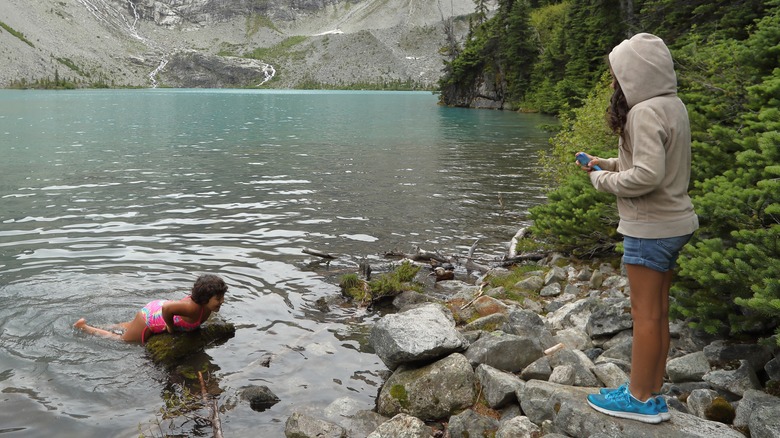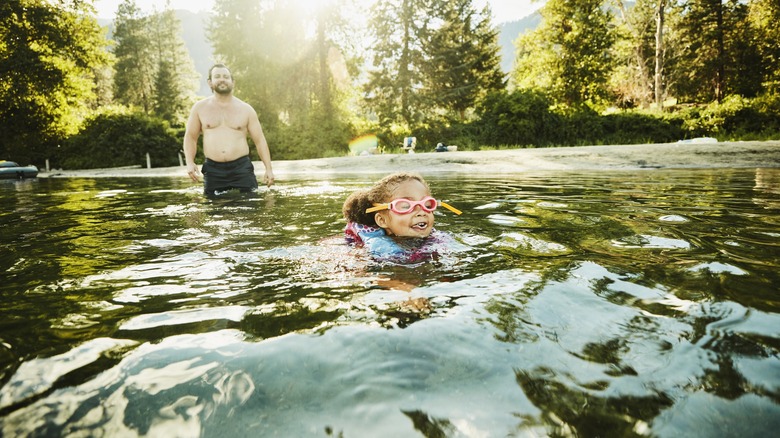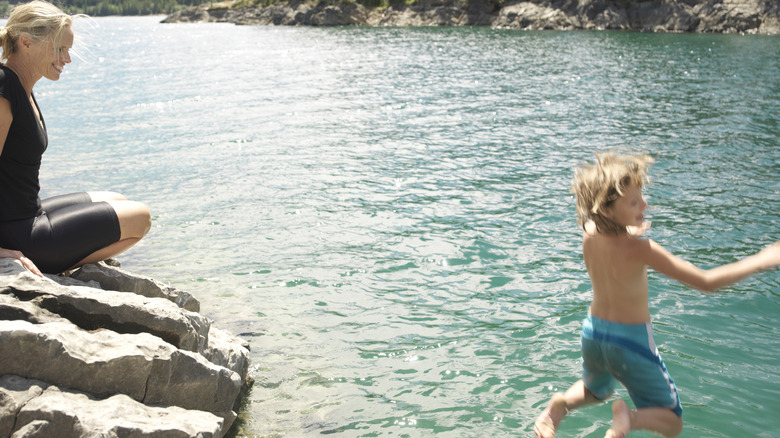The Importance Of A 'Water Watcher' On An Outdoor Family Trip, Per National Park Services
During the hot summer months, there's nothing quite as refreshing as taking a plunge into a beautiful natural swimming hole. Swimming is one of the most popular pastimes, and national parks and nature preservations around the world offer perfect opportunities to beat the summer heat, splash around with family and friends, and soak up the natural scenery. America's National Park System is full of epic and unforgettable places to swim. Scenic lakes, meandering rivers, and waterfalls are scattered all across the nation, and on hot days you'll often find them packed with both locals and tourists.
That said, these popular places aren't without their risks. Unlike public pools, many natural swimming spots don't have lifeguards on duty, and according to the National Park Service (NPS) website, "most fatal drownings happen when there is poor or absent supervision." In order to ensure that everyone has a fun and safe day of swimming, NPS recommends designating a "water watcher" every time swimming is on the agenda.
A water watcher helps keep swimmers safe
According to the CDC, from 2020 to 2022, over 4,500 people in the United States died due to drowning each year. It's the most common cause of death for children between the ages of one and four. According to the report, small children and adults over the age of 65 are the most at risk, but drowning can happen to anyone. Furthermore, there are around 40 million adults in the United States who don't know how to swim. In America's national parks, drowning is the second most common cause of unintentional death. From 2014 to 2019 there were 314 recorded drownings within the national park system (per NPS). Virgin Islands National Park, for example, is considered one of the most dangerous, due to drownings.
The risk of drowning can be greatly reduced with some safety precautions. According to the National Park Service, a water watcher is "someone who supervises children, adolescents, and those with little or no swimming skills." The water watcher should stay in the swimming area within arms reach of the swimmers and remain attentive and without distractions during their duty. A water watcher is not a replacement for a lifeguard, but it's a good idea to designate one even if lifeguards are present as an extra safety precaution, especially when supervising small children or non-swimmers. Furthermore, the NPS recommends that every swimmer, regardless of experience level, should wear a certified personal flotation device when swimming at the beach or other natural bodies of water.
How to be a great water watcher
If you're taking on the role of water watcher for your group, remember that it is an important and potentially life-saving job. Be attentive, and take the responsibility seriously. Adults make ideal water watchers, but a responsible young adult over the age of 16 works, too. A water watcher, much like a designated driver, should always remain sober and alert. Ideally, the designated water watcher in your group will be someone who knows CPR and who is familiar with water rescue. The American Red Cross offers some excellent online and in-person water safety courses as well as CPR training. You should have an accessible phone in case you need to quickly call emergency services. Additionally, it's a good idea to have a flotation device that you can throw to a swimmer who is struggling.
By designating a water watcher, you're well on the way to having a safe and fun swimming experience, but consider taking further precaution by "layering" water safety techniques. Wear a personal flotation device, take swimming lessons if you don't feel confident swimming in open water, choose to swim only when a lifeguard is present, and always ensure that you've checked water and weather conditions – especially in natural bodies of water. Oceans, rivers, and lakes across the U.S can be particularly risky.


